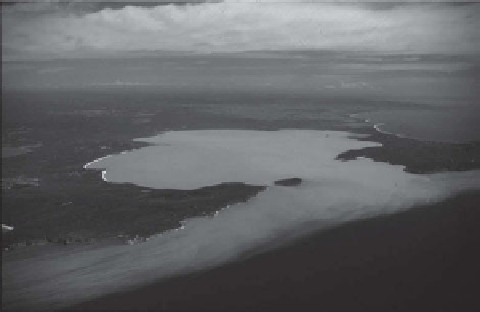Geoscience Reference
In-Depth Information
Figure 10.22
See
colour plates version.
Photograph of a coccolithophore bloom in Jervis Bay,
east Australia, following the upwelling of nutrients driven by a filament of the East Australia
Current impinging against the shelf edge (Blackburn and Cresswell,
1993
). Image provided by
Susan Blackburn, CSIRO, photographer Ford Kristo, Australian National Parks.
Reproduced with permission from CSIRO Publishing.
An upwelling favourable wind event does more than input nutrients over the shelf
edge. During the upwelling winds, surface water will be transferred off-shelf, and so
export the carbon fixed in the surface waters as a result of earlier upwelling. The
filaments mentioned earlier in this section are one mechanism for efficient transport
of surface waters off the shelf, with rates of transport measurable using satellite
imagery (Gabric et al.,
1993
). Off Monterey Bay, part of the California current
system, a strong correlation between surface primary production and the export of
particulate organic carbon (POC) into the deep water of the continental slope has
been seen in normal upwelling years (Pilskaln et al.,
1996
). The same study also
showed that in El Nin˜ o years, with very low nutrient upwelling, the correlation was
substantially reduced as the phytoplankton community shifted from large diatoms to
much smaller picoplankton and flagellates.
10.6.2
Biological response to upwelling under along-slope flow
Apart from upwelling forced by wind stress, we have seen (
Section 10.3.2
) that the
along-slope flow of a western boundary current trapped against the slope topography
can drive upwelling through the bottom frictional Ekman layer. Clear evidence of a
biogeochemical response to this process is limited. An example of a biological
response attributed to such a current-driven upwelling event has been recorded off
the east coast of Australia. In this case, the East Australian Current, the southwest
Pacific equivalent of the Gulf Stream, develops large meanders and filaments which
can impinge against the shelf slope.
Figure 10.22
shows a dense bloom of coccolitho-
phores in Jervis Bay, 130 km south of Sydney, triggered by nutrients that arrived in
the coastal water as such a filament impinged against the upper continental slope
(Blackburn and Cresswell,
1993
).




Search WWH ::

Custom Search